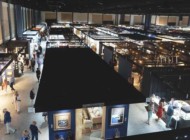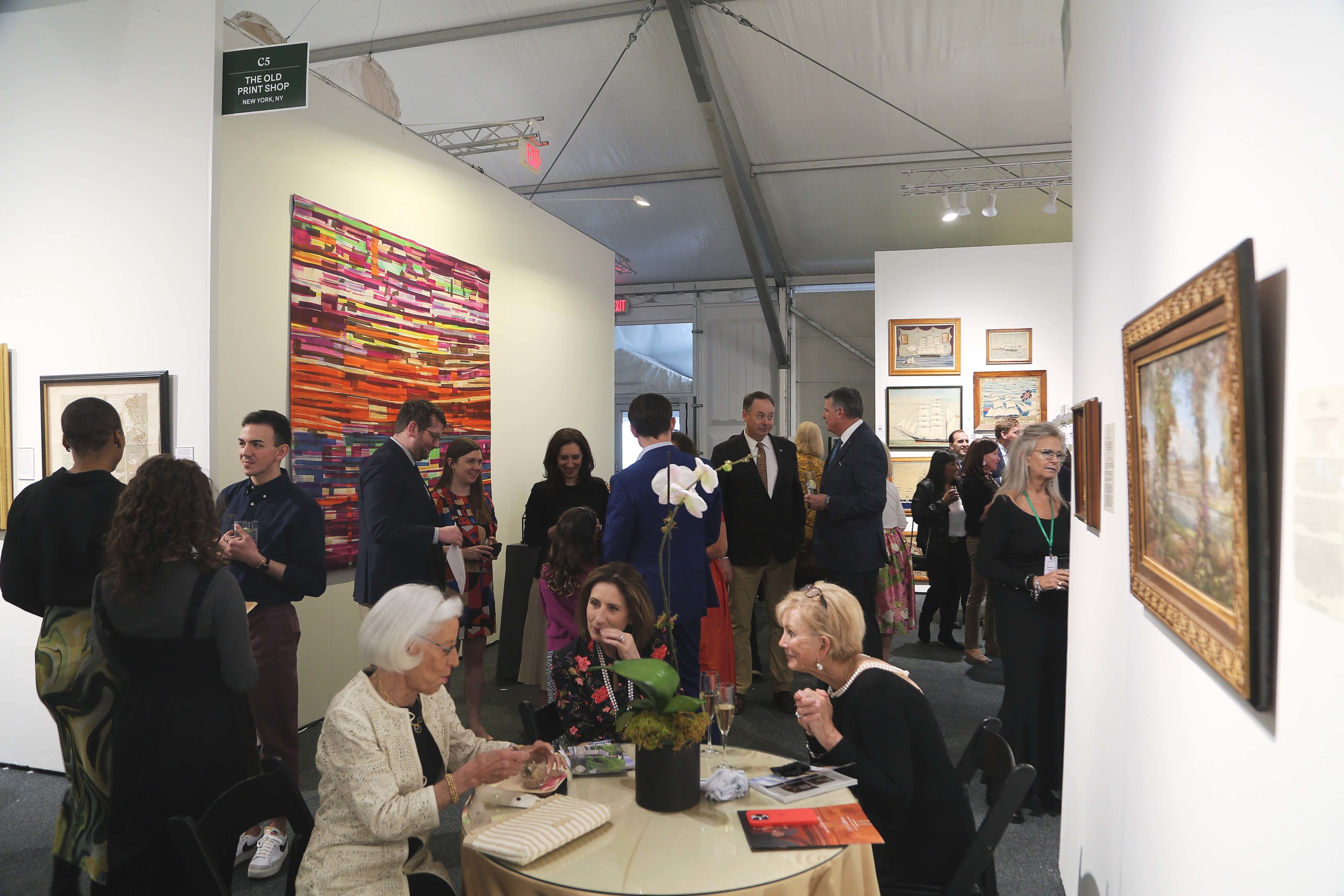
Eating, drinking, shopping and catching up were on the agenda at the Opening Night party for the 62nd Philadelphia Show.
Review By Madelia Hickman Ring
PHILADELPHIA — From April 26-28, the Philadelphia Museum of Art (PMA) welcomed collectors, dealers and curators to the 62nd edition of the Philadelphia Show, a benefit for the PMA’s Learning and Engagement division. Funds raised from the show allow for year-round family programming and free or low-cost visits for students and educators from Philadelphia’s school district. Philadelphia society, museum trustees, collectors, dealers and curators turned out in force for a glittering Opening Night preview party on Thursday, April 25.
The team that pulls together the Philadelphia Show, which is managed by Huntley Platt, lined up a number of events to draw people to the show, including a talk by senior producer of Antiques Roadshow Sam Ferrell with some of the dealers at the show who have appeared as appraisers on the popular series. For the first time since the pandemic, booth talks by dealers resumed on all three days of the show’s run, on topics ranging from Gilded Age table decoration, Palmer Hayden and the Harlem Renaissance, profiles in American folk art, prisoner-of-war ship models and the women behind Tiffany Studios. In lieu of a loan exhibition, the museum created special labels for works within the museum that it has acquired during previous editions of the show; Alexandra Kirtley, the PMA’s Montgomery-Garvan curator of American decorative arts, penned an essay for the show’s catalog outlining some of these. Prior to the show’s opening, Kirtley and Philadelphia designer Barbara Eberlein co-hosted a panel titled “Collecting, Gathering and Curating Americana: A Conversation with Michael Diaz-Griffith” in the museum’s new Learning & Engagement center; Diaz-Griffith lingered afterwards to sign copies of his recently published book, The New Antiquarians: Young Collectors at Home (Phaidon, 2023).
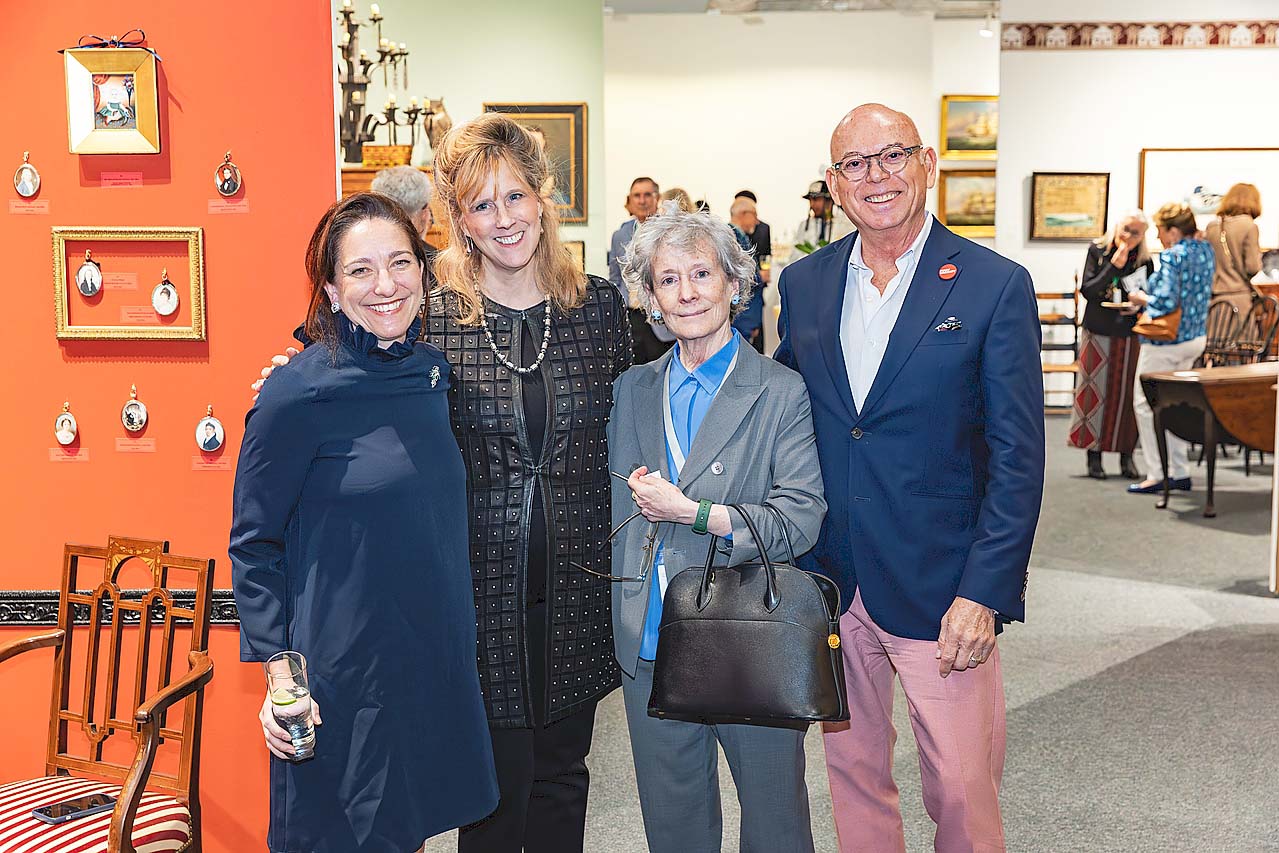
From left, Huntley Platt (show director), Amy Fox (show chair and PMA trustee), Kitty Bowe Hearty and Romula L. Diaz Jr (PMA trustee). Daniel Burke photo.
After the show closed, Antiques and The Arts Weekly got glowing feedback from Platt.
“The dealers always bring out their best things, but I felt this year was extra special. The show felt very full and we had a great response to our programming, which was very well attended. Turnout was strong throughout the weekend. We had more than 500 people on Opening Night and 563 came on Friday, which is great for a weekday. Our busiest day was Saturday, when we had 900, about the same as we had last year. Almost that many came on Sunday.”
Nine dealers were participating for the first time and all were happy to be there. Five were specialists in fine art — the others were more object-oriented — but all contributed to a varied presentation under the tent.
From Port Washington, N.Y., Scott Defrin of The European Decorative Arts Company, showcased many things, including a Viennese enamel and silver gilt plate attributed to Hermann Ratzerdorfer (1843-75) and a group of three porcelain cups and saucers, two of which were KPM with exhibition history and one from the Twinight collection. Defrin reported two good sales. A collector in Philadelphia, who Defrin had never sold to before, purchased a large earthenware plaque in its original frame that depicted the Château de Fontainebleau. An existing client from New Jersey acquired a carriage clock, a category which Defrin said he has extensive experience handling.
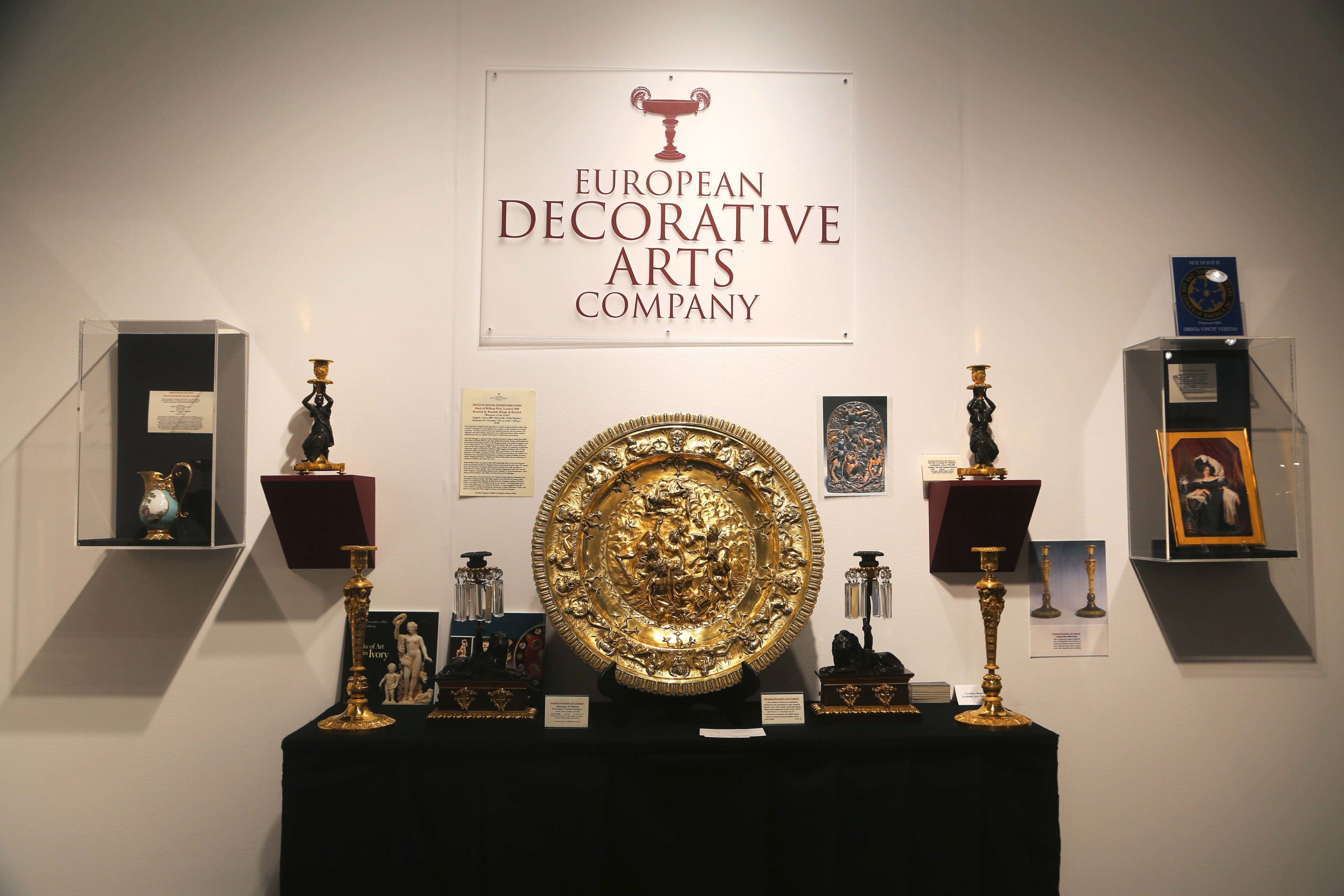
Debuting at the Philadelphia Show, Scott Defrin featured an impressive sideboard dish bearing the mark of William Pitts, London, 1809, that had been retailed by Rundell, Bridge & Rundell with a pair of Russian gilt bronze candlesticks from the Moscow workshop of Yakov Samarin, ex, A La Vielle Russie; and a pair of Messenger & Phipson Regency candlesticks. European Decorative Arts Company, Port Washington, N.Y.
“It was a pleasure to be among the great dealers, who are so knowledgeable and who have been there for decades. It’s a very well-run show, looks great and is easy to do,” Defrin said, noting he would likely be returning for future editions.
Howard and Amy Rehs staffed two booths, one for traditional Nineteenth and early Twentieth Century fine art that Howard manned. Across the show’s floor, Amy held court with contemporary works of art. When Amy called us after the show, she said, “overall, the show was wonderful. I was beyond impressed with Huntley as well as the entire committee and board of trustees, who were all so welcoming and so appreciative of us being there. It was a very nice first time experience.”
She reported a few sales, all to new clients, including works by Stuart Dunkel, landscapes by Ben Bauer and Leo Mancini-Hresko and a painting of ducks with boxing gloves by Lucia Heffernen. Of particular interest were a few works by contemporary landscape and marine artist John Stobart (1929-2023), whose widow has just begun to allow some of his paintings to be sold on the market. Howard had a steady stream of interest in his booth throughout the show, including interest from some museums.
Hawthorne Fine Art, another first-time dealer, specializes in Nineteenth and early Twentieth Century American art, including Hudson River school, Realist, Impressionist, Ashcan and Modernist works. In addition to paintings on the walls, a table in the middle of the booth displayed small watercolors, prints and two pencil on paper figural works by Mary Cummings Browne.
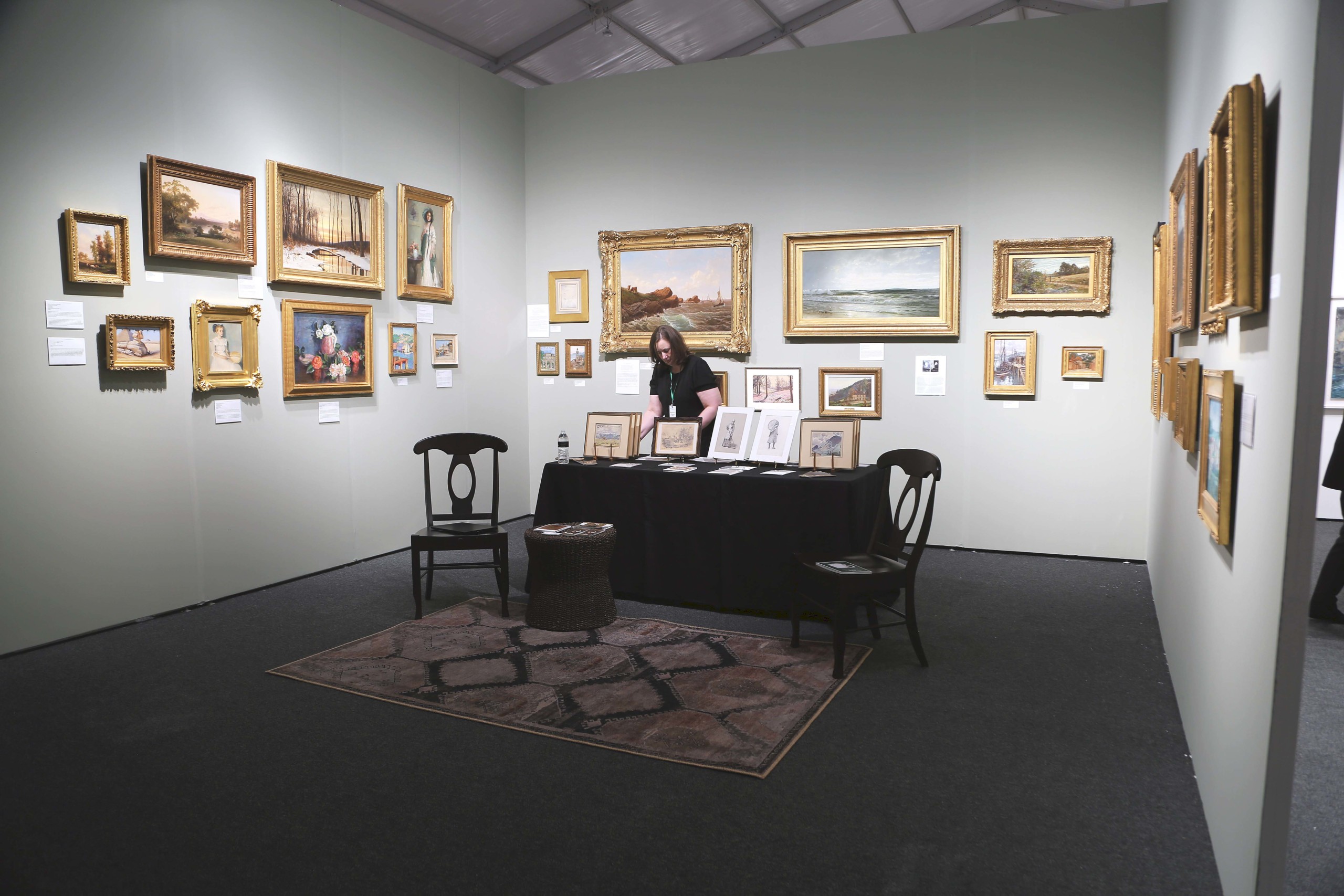
Megan Bongiovanni, research associate with Hawthorne Fine Art, was doing some last-minute tweaking of things before the doors opened on opening night. The wall behind her was hung with two landscapes, one on the left by Ann Sophia Towne Darrah titled “Cattle by the Sea” and William Trost Richards’ “Seascape with Crashing Waves.” New York City and Irvington, N.Y.
David Walker was a specialist in Nineteenth Century English and Continental furniture, silver and decorative arts at both Sotheby’s and Freeman’s but he has since hung up his own shingle and is the proprietor of Walker Decorative Arts, in Nyack, N.Y. He said the Philadelphia Show was his first show and he was thrilled to be there. His booth showed a variety of influences, from Iznik pottery to Regency furniture and a Laverne table from the 1960s.
“I really enjoyed the show. I found it a success and was glad to receive so much positive feedback for my booth, as well as great support from Huntley, all the organizers and fellow exhibitors. It was my first Philadelphia Show and I look forward to returning in 2025. I sold several things, all to new clients, and a variety, including a Philip and Kelvin Laverne ‘Chan’ table, circa 1965, to a couple younger than me; a Twentieth Century Oceanic spirit board; an Eighteenth Century silver loving cup, hallmarked Dublin and with period provenance; and a period copy, circa 1830, of a portrait of King George IV, after Sir Thomas Lawrence.”
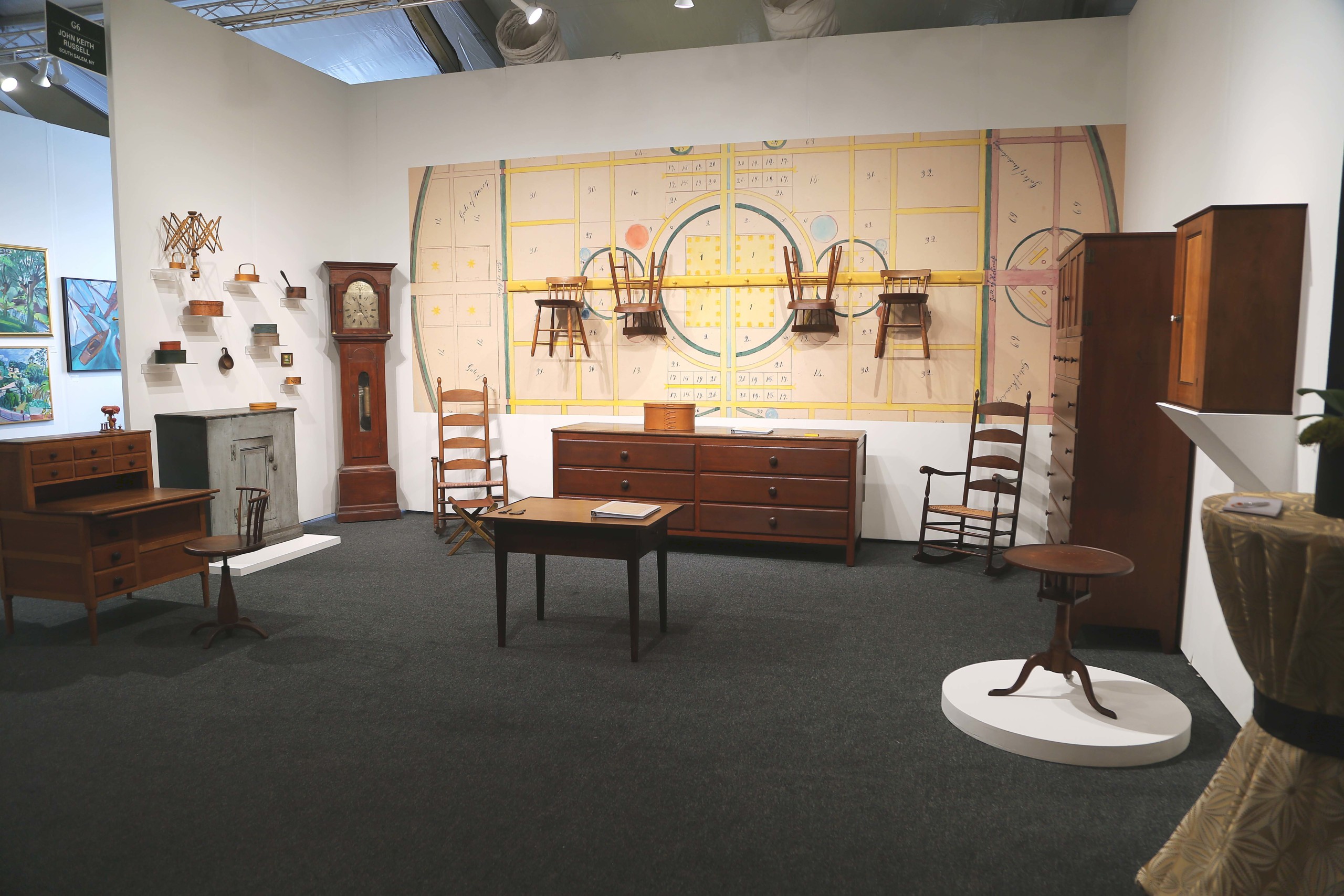
John Keith Russell, Shaker specialist, was new to the show. The clock in the corner and blue-painted cupboard next to it were among the pieces he pointed out as being particularly important. John Keith Russell Antiques, South Salem, N.Y.
Down the aisle from Walker, John Keith Russell had a booth that radiated calm and simplicity, befitting the Shaker works of art he sells. For the artwork along the back of his booth, he’d used a detail from a drawing in the Philadelphia Museum’s collection that depicted “The Holy City” by Polly Ann (Jane) Reed (1818-1881). A work counter from Enfield, N.H., circa 1840, sat below a strip mounted on the wall from which were hung small Shaker chairs. Among the most impressive pieces in his booth was a tall case clock, possibly by Brother John Winkley (1767-1813), with a silvered brass dial embellished with the hand-painted botanicals of Sister Cora Helena Sarle (1867-1956). Another stand-out piece was a one-door Shaker pine cupboard in old blue paint.
For the show, Russell created a page on his website that featured all of the things he took to the event; this went live at 11 am on Friday morning, the same time the show opened to the public. This allowed people who could not come to Philadelphia the chance to purchase things that were there. Nearly a dozen pieces were marked as sold at press time, including the Shaker one-door cupboard in old blue paint, a Shaker cupboard over drawers, dry measure, lift-lid collar box with collars, four oval storage boxes and a painting of Old Church by Sister Cora Helena Sarle.
“For us, the show was excellent. We sold a substantial amount of what we brought, big and small things but no ‘medium-sized’ things. And everything was sold to people we already knew.” He noted that having works at the show simultaneously on his website gave potential online buyers some urgency knowing the items were also being looked at by show visitors.
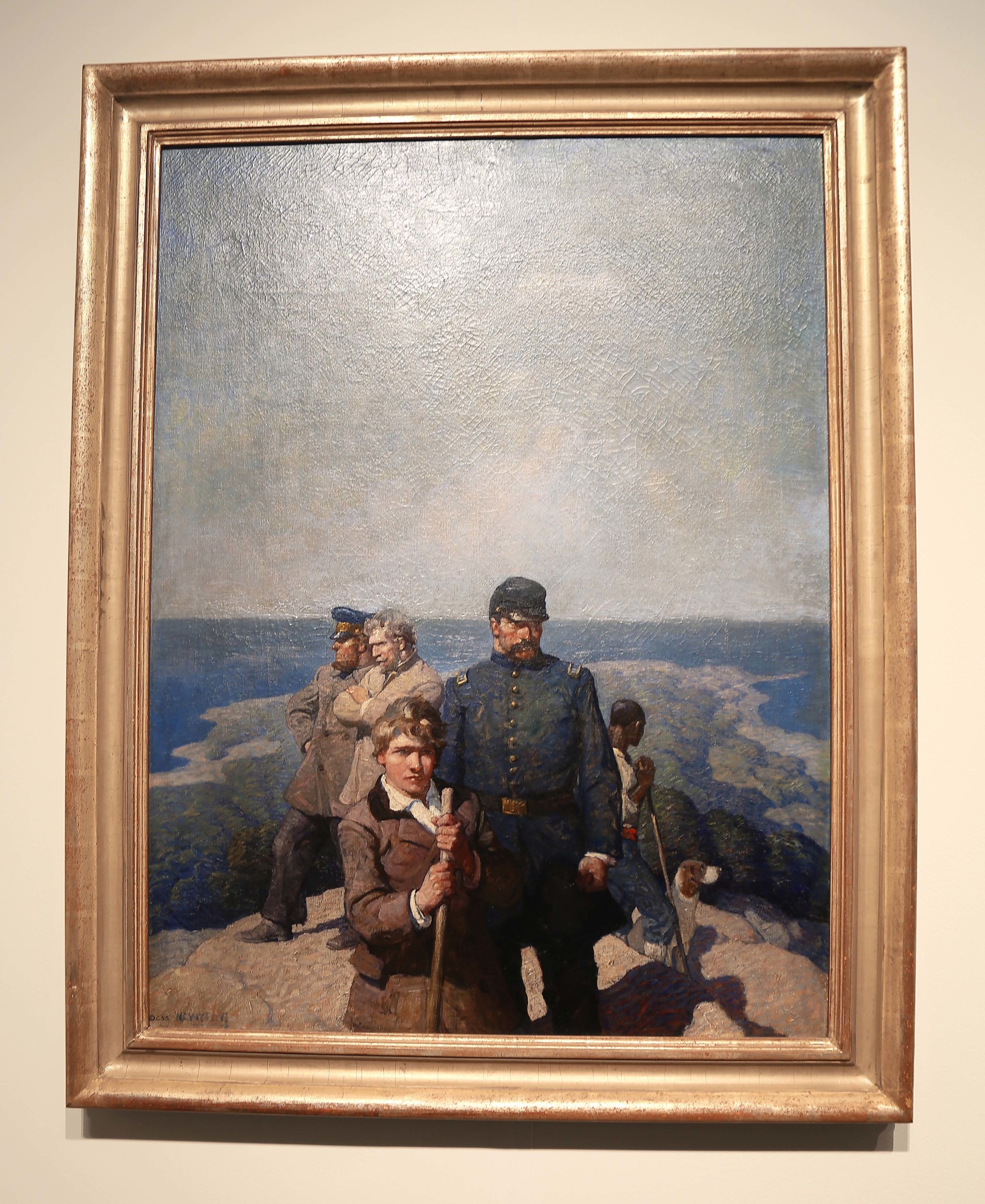
“Marooned” by N.C. Wyeth (American, 1882-1945), 1918, oil on canvas, 40 by 30 inches. Bernard Goldberg Fine Arts, New York City.
Gallery director Ken Sims of Bernard Goldberg Fine Arts brought several works by blue-chip artists to the show for their debut, including N.C. Wyeth’s “Marooned” from 1918, Hunt Diederich’s “The Jockeys,” “Seal” by Reuben Nakian and “Big Ginger Flower,” Agnes Pelton’s diminutive but powerful oil on canvas from 1925, which was hung alongside a coastal view made by Hugh Breckenridge.
Illustration art has been a hot market, so the recent inclusion of that category at the show was a welcome one. The Illustrated Gallery, from Fort Washington, Penn., brought works by Jessie Wilcox Smith, Ellen Pyle, Rose Cecil O’Neill, Sarah S. Stilwell Weber, Dean Cornwell, Frank J. Reilly, Charlotte J. Sternberg, James A. Bingham, J.C. Leyendecker, Howard Chandler Christy, Saul Tepper and Norman Rockwell.
Gustave Louiseau, Emile Mesnager, Charles Perron, Gustave Courbet, Raymond Wintz, Jeanne Selmersheim-Desgrange were represented by debuting London dealer, Gladwell & Patterson, which also brought a striking equine bronze by Edward Waites, from an edition of seven.
Ella Wells, Gladwell & Patterson, sent post-show thoughts via email: “We had a good show, with some small sales, as expected as first-time exhibitors. A lot of our existing clients have other homes in Philadelphia, so it was lovely seeing familiar faces, but we also sold small pieces to new collectors who are starting their collections.”
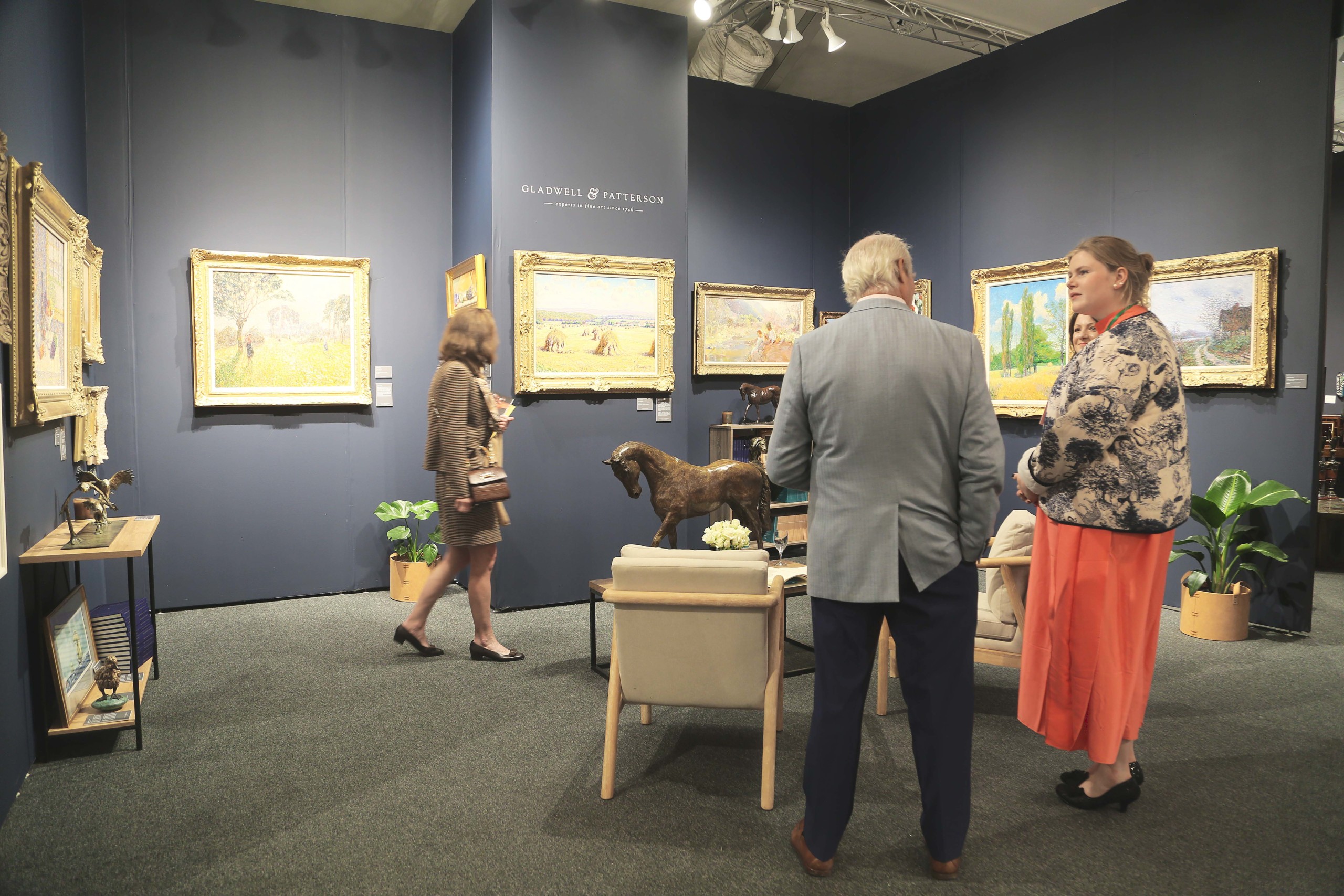
New exhibitor Gladwell & Patterson, London.
Eric Hanks was the only exhibitor to debut at the Philadelphia Show in 2023 and he was back again, bringing a good selection of works by African American artists that is the specialty of the M. Hanks Gallery.
“The show was great for me. I brought works by several African American artists but the paintings by Palmer Hayden, Horace Pippin and Henry Tanner received the most attention. Perhaps it’s no surprise that happened given I featured several works by Hayden and he’s part of the Harlem Renaissance exhibition at the Metropolitan Museum in New York, and Tanner and Pippin are well known and both from Pennsylvania.
“But as it turns out, as I was informed by two different curators who visited my booth, the Philadelphia Museum of Art in 1899 purchased in Paris directly from the artist “The Annunciation” executed by Henry Tanner in 1898. The work I had in my booth by Tanner, was also a religious themed work created that same year titled, “And He Vanished from Their Sight.” They said it too is an important painting by Tanner. Having that kind of feedback from experts in the field and scholars of Tanner’s work in particular by itself made my participation in the Show worthwhile. I had similar reactions to the Pippin work and had a lot of interest in his charming little painting, ‘Love Note.’”
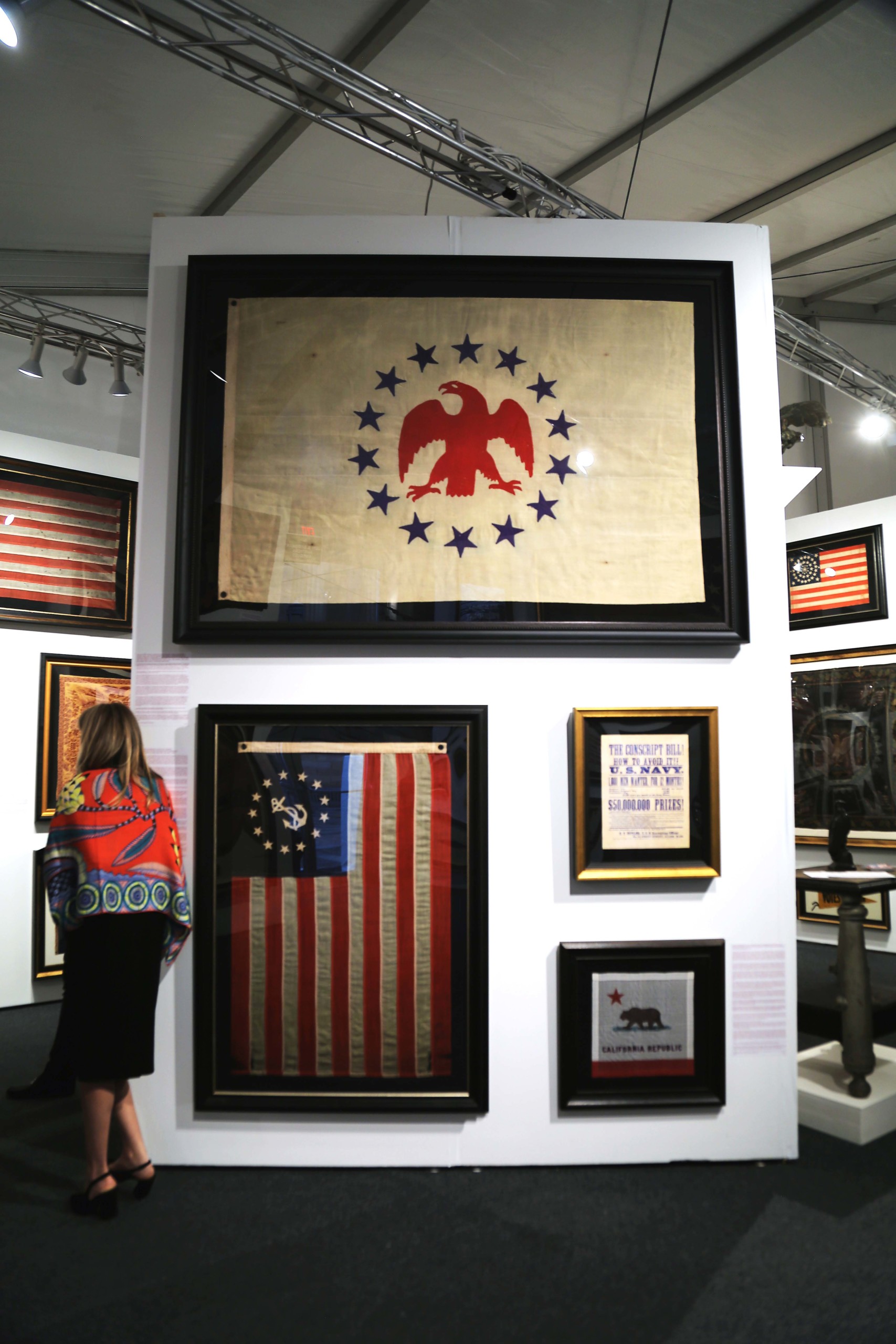
One of Jeff Bridgman’s favorite pieces was a white-ground hand-sewn flag with appliqued eagle and stars made between 1852 and 1860 for the Hudson River Steamship Delaware by the Manhattan flag-maker Sarah McFadden, who is known as “The Betsy Ross of New York.” Jeff R. Bridgman American Antiques, York County, Penn.
Flag specialist Jeff Bridgman occupied a large booth that dominates a forward corner at the show. Exhibiting since 2011, the York County, Penn., dealer had several exceptional pieces that were not flags, including a circa 1875 paint-decorated Odd Fellows “heart-in-hand” staff and a Civil War-era chess set with the board featuring photos of Lincoln and Army generals, made by Walter S. Hill and Samuel T. Reed in New York City. For rarity, it would be hard to beat a circa 1912-19 suffragette armband in golden yellow felt, one of just two known examples, that was mounted in a walnut frame.
Levy Galleries, originally Ginsberg and Levy before being Bernard & S. Dean Levy, has a long history at the Philadelphia Show, having started exhibiting there in 1972. Noteworthy case pieces Frank Levy took this year included a diminutive Federal sideboard attributed to Rhode Island cabinetmaker, Thomas Howard Jr, a Philadelphia Chippendale lowboy, circa 1760, possibly by Henry Clifton and Thomas Carteret and a Chippendale blockfront chest of drawers.
“I was very pleased with the show and had a number of sales and a few to new clients. I thought the show was beautiful and brought in a lot of top collectors from all over the country. I also think the proximity to the museum is a huge plus. I am not sure they could find a better location,” Levy told us.
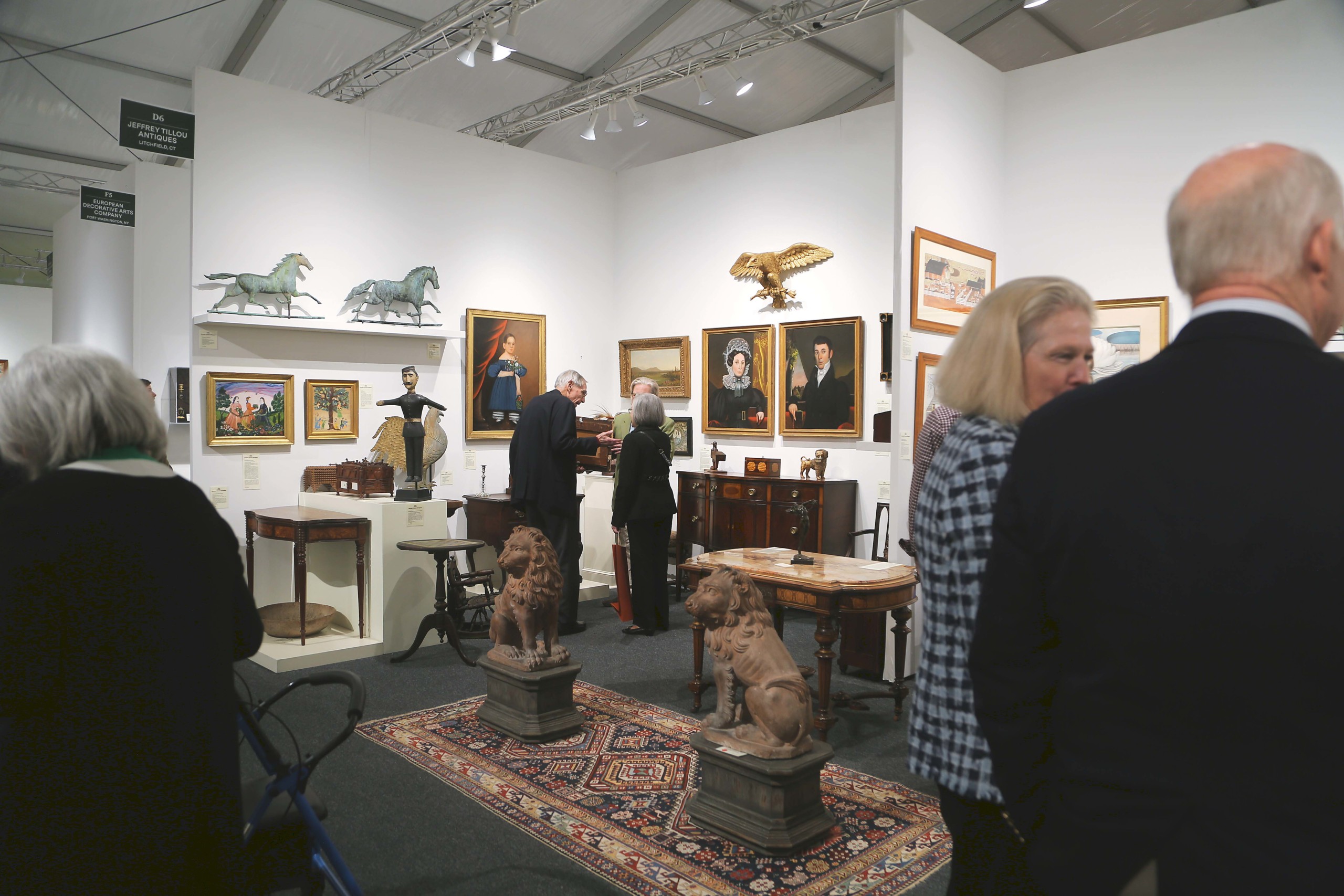
Jeffrey Tillou was in a new place on the show floor: a spacious double-wide booth towards the show’s back. The pair of lions at the front of his booth were sales early on. Jeffrey Tillou Antiques, Litchfield, Conn.
Jeff Tillou is a contemporary of Levy’s and another dealer whose family has participated at the show since its inception. On Opening Night, the Litchfield, Conn., dealer sold a pair of lions and a coastal seascape by C.H. Gifford. A Chan coffee table by Philip and Kelvin Laverne, circa 1965, and a turned wood bowl by Edward Moulthrop were among more modern offerings. For whimsy, he brought a child’s rocking chair made from spinning wheel parts that had an inscription underneath that read “Built by Jay Kline 1893 / Owner H.H. Kline.”
“We sold across the board,” Tillou reported. “Three of four pieces of furniture, some folk art, a few Nineteenth Century paintings, a few Twentieth Century paintings and some decorative art pieces. These days we use shows as platforms to send out eblasts and ads, which usually results in a few more sales to folks who can’t get to the show.”
Skip Chalfant has been doing the show since 1984 and brought a few newly acquired things to the show, including an English or Welsh William and Mary inlaid walnut and pine low chest dated 1696, a circa 1775 Pennsylvania Chippendale carved mahogany easy chair and a New York Chippendale mahogany serpentine card table that dated to 1760-65. He reported selling a gateleg table, a large bowl and a pair of good andirons.
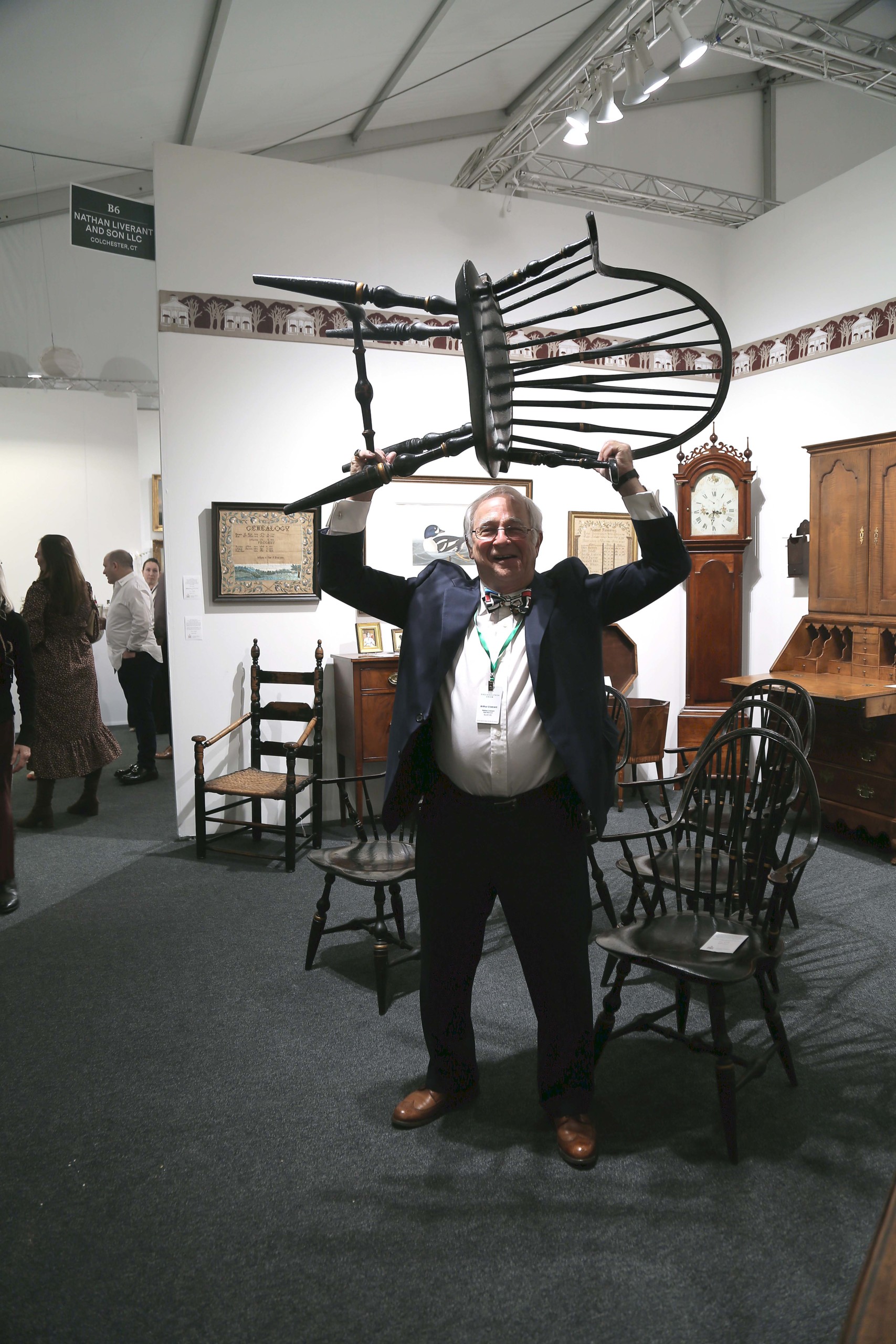
The Philadelphia Show tent is impressively situated at the top of the Philadelphia Museum’s “Rocky Steps” and visitors to Philadelphia invariably run to the top of the steps and hold their arms above their head as Rocky Balboa (played by Sylvester Stallone) did in the movie, Rocky. Arthur Liverant got into the spirit of the location, channeling Balboa by hoisting one of six continuous arm braceback Windsor chairs owned by General Samuel McClellan that were attributed to Elijah Tracy, Lisbon, Conn., 1785-1805.
Arthur Liverant told us that he had spent 65 years courting the family of Brigadier General Samuel McClellan (1730-1807). His persistence recently paid off and he brought a handful of things to the show. These were a portrait of McClellan painted by Ralph Earl (1751-1801) in 1797, a set of six continuous arm brace-back Windsor chairs, a pair of brass andirons and a tall-case clock.
There were equally impressive pieces in the booth of Patrick Bell and Ed Hild, Liverant’s across-the-aisle neighbors. The middle of the booth was anchored by a circa 1852 pieced cotton Starburst quilt made in Freehold, N.J., and a Pennsylvania German pine dower chest, Centre County, Penn., dated 1829, that retained its original polychrome decoration. These were flanked by a circa 1900 prancing carousel horse attributed to the Dentzel Company of Philadelphia, that was described as having “exceptional surface” and, on the other side, an elaborately carved, stencil and grain-painted doll house signed on the bottom “Samuel S. Reed, December 15, 1898/Shamokin, Pa.”
“I really love the Philadelphia Show. It looked great, it should be stated that what they’ve done with the Philadelphia Show makes it one of the most imposing and impressive shows in the United States. It competes with the best fairs in the world,” enthused Bell.
Jasmine Doussiere, Silver Art by D&R, reported three sales on Opening Night: a group of Eighteenth Century French etchings and two smaller paintings. By the time the show closed, she and her husband, Thierry, had written additional receipts for an Empire sugar bowl, bronze lamps, a Restauration gilt bronze and a three-piece plateau.
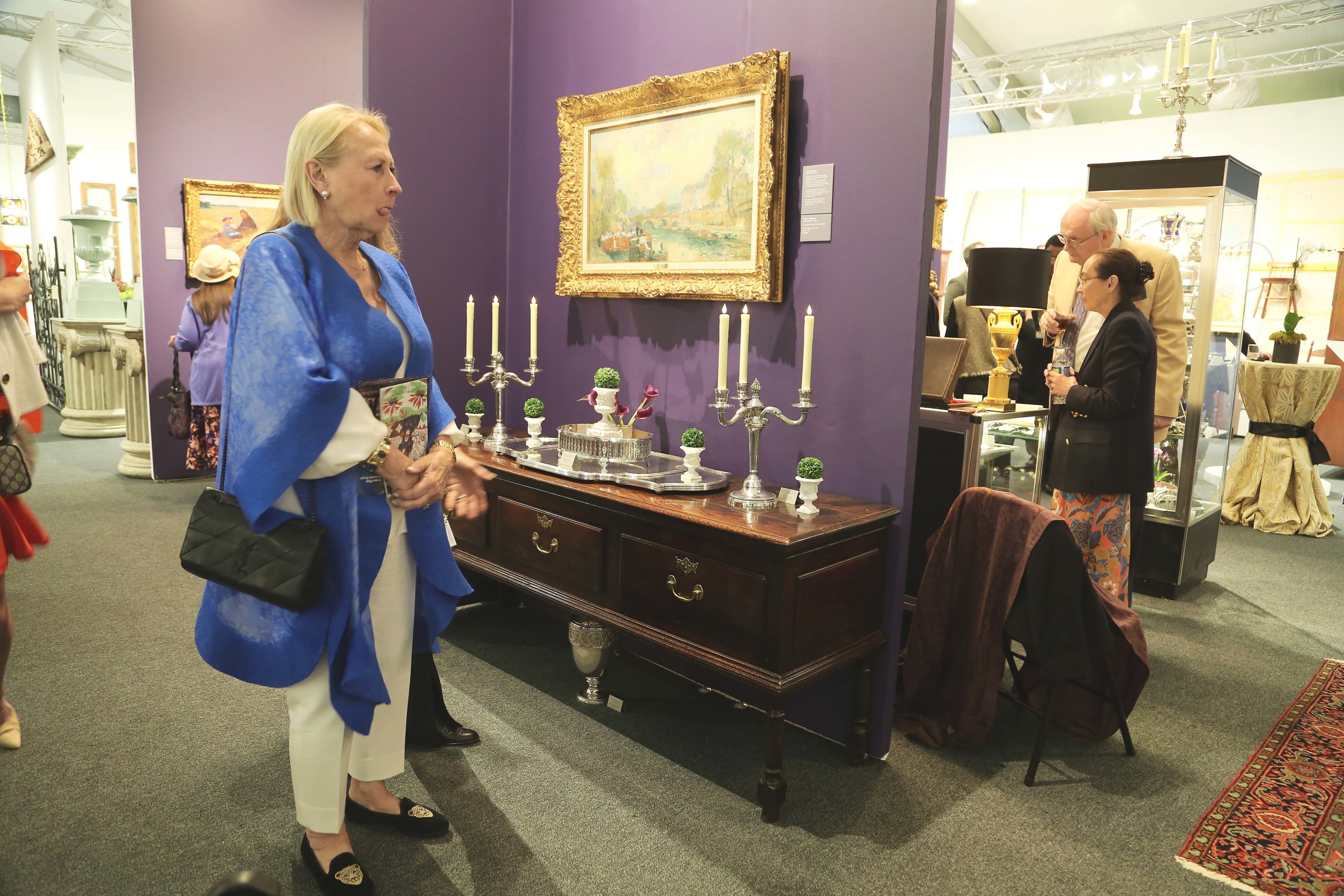
Albert Marie Lebourg’s “Barges In Front of the Pont Neuf” is marked as “sold” on the website of Silver Art by D&R. It was hung over a pair of Louis XVI-style silver candelabra by Hénin & Cie of Paris and a three-piece surtout. Baltimore and Marseilles, France.
“I thought attendance was very good and the show looked gorgeous. What was good for us more than anything else was the fact that we had a lot of new clients. That is the name of the game and we’re really happy about that. You can usually bank somewhat on the old ones coming but many of them were traveling this year.”
Ralph M. Chait Galleries is also one of the longest-running exhibitors at the Philadelphia Show, doing it since its inception in 1969. Some of the stand-out pieces in the booth, which was overseen by brothers Steven and Andrew, included an ormolu mounted Chinese porcelain vase from the Qianlong period, second half Eighteenth Century with mounts relating to examples in the British Royal collection. A large Chinese iron figure of a Bodhisattva, Yuan or early Ming dynasty, Fourteenth or Fifteenth Century, had provenance to the French collections of both Jacques Barrere and Armand Trampitsch. John D. Rockefeller had once owned a rare pair of Chinese famille noire porcelain beaker vases, Kangxi period, late Seventeenth Century that were exhibited in 1963 at the Arkansas Arts Center in Little Rock.
Moderne Gallery, situated in the center of the show on the raised dais, brought several exceptional pieces in a wide variety of media. From red leather dining chairs by Michael Hurvitz to Mark Sfirri’s wood and paint rolling-pin-like sculpture titled “Homeland Security.” All paid homage to Dan Jackson’s 1974 masterpiece, “Rocking Unicorn.” Furniture by George Nakashima and Ashley Joseph Martin paired nicely with woodcuts by Wharton Esherick. A post-event press release issued afterwards noted the Philadelphia gallery sold a console by Philadelphia-based artist, Miriam Carpenter.
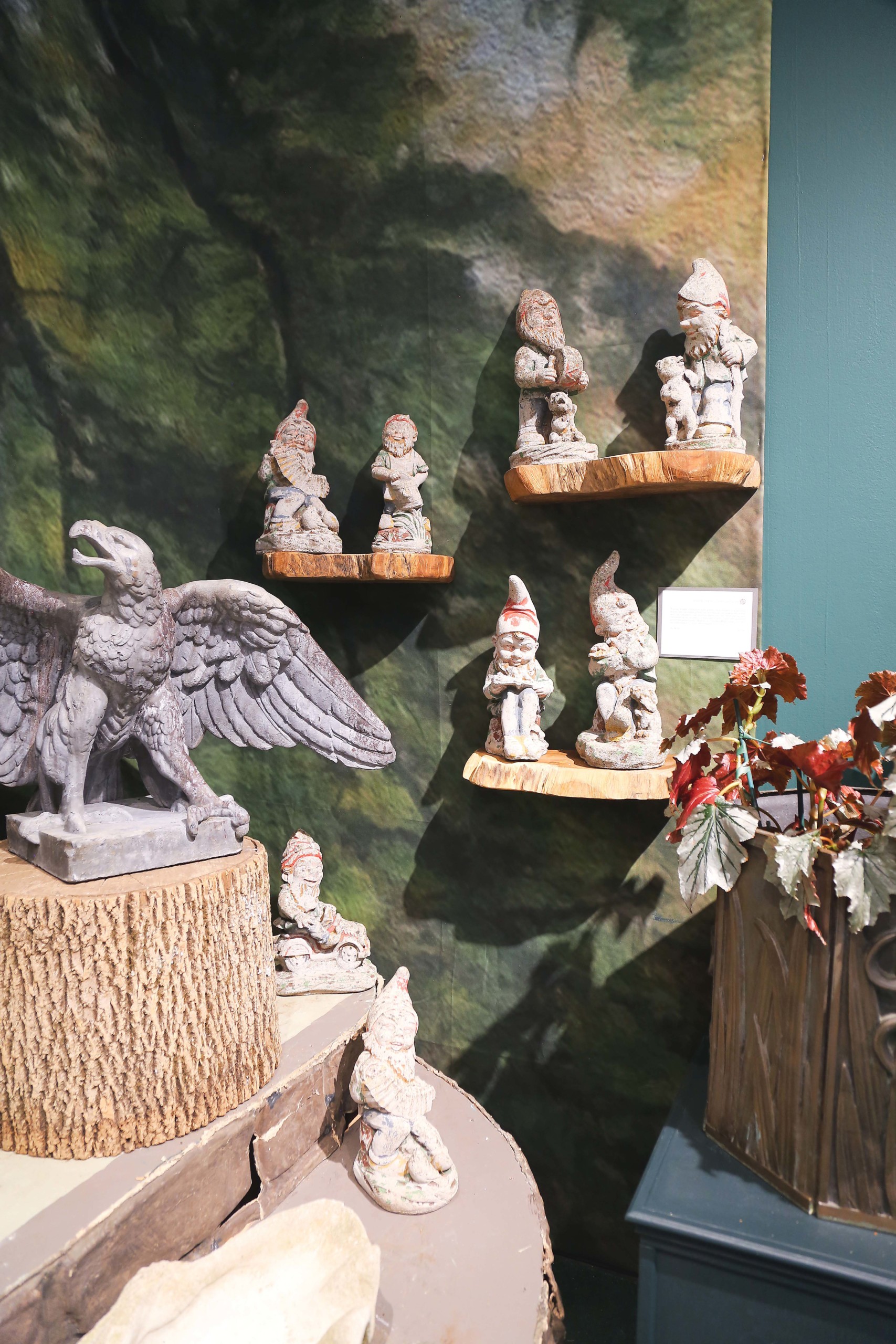
Tucked among Classical figures, stone eagles and iron urns was this set of eight mid-Twentieth Century English composite stone garden gnomes or dwarves; they sold opening night. Barbara Israel Garden Antiques, Katonah, N.Y.
Statuesque Classical-style marble or stone statuary, painted iron furniture, fountains, eagles, armillary spheres, sundials and urns are the stock garden antiques specialist Barbara Israel typically brings to the shows she does. A circa 1890 Italian faun with pipes, bronze figural sundial with a satyr by Robert Ingersol Aiken and a French cast iron figure of Diane de Gabii were among her larger pieces. For the Philadelphia Show, the Katonah, N.Y., dealer added an additional touch of whimsy with a set of eight composition garden gnomes. Finding a new home on Opening Night was a mid-Twentieth Century American composite stone clam shell planter.
“It was a good show!” enthused Israel. “We didn’t sell any of the major statues but we sold the fountain in the middle of the booth, some eagles, a birdbath, two of my dog sculptures and, to the same person, a pair of console tables and urns that were on top of them.”
The Schwarz Gallery has been showing at the Philadelphia Show since 1982 and now Robert D. Schwarz Jr, the third generation to preside over the gallery, set up across the aisle from Israel. An eye-catching work was Richard Blossom Farley’s “Bargnegat Beach,” a 1913 oil on canvas that had been extensively exhibited, at the Philadelphia Academy of Fine Arts, the Memorial Art Gallery (Rochester, N.Y.), the 1915 Panama Pacific International Exposition in San Francisco, the Art Institute of Chicago and the Peabody Institute in Baltimore, Md.
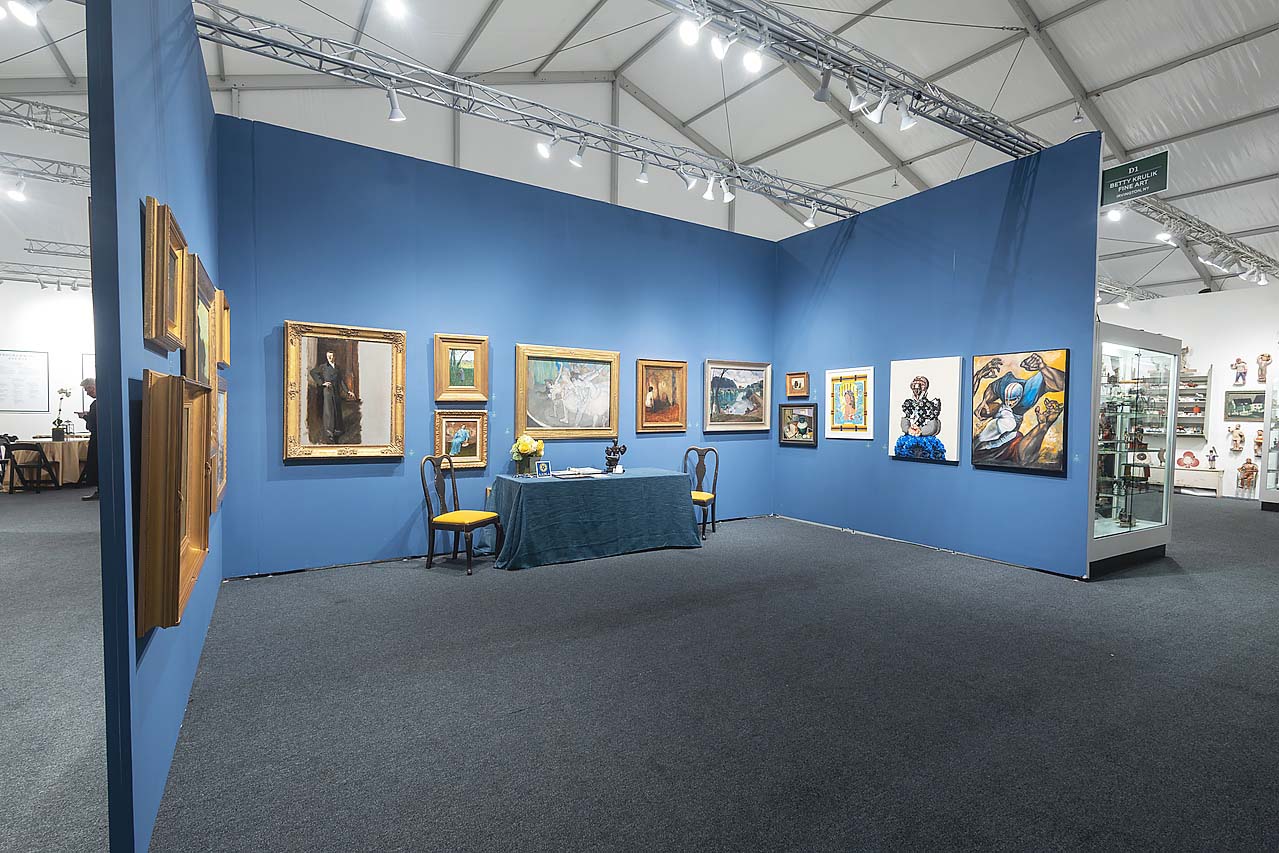
Betty Krulik Fine Art, New York City. Daniel Burke photo.
Works by American artists spanned a broad range in the booth of Betty Krulik. Nineteenth and early Twentieth Century works included a portrait of W. Graham Robertson by John Singer Sargent, Gari Melchers’ “Geisha at Rest,” Louis LeGrand’s pastel on paper masterpiece “Danseuses Salutant” and “Woman at a Dressing Table” by Guy Pene Du Bois. For still life pictures, one could choose between Joseph Stella’s “Still Life with Figs” or “Kitchen Still Life” by Robert Lee Neal. One of the New York dealer’s masterworks was “The Fullback,” Ernie Barnes’ iconic work that had been in the family of Mrs Nat King Cole (Maria Ellington Cole), was exhibited in 1968 in Los Angeles and published in Ernie Barnes’ From Pads to Palette (1995). She shared some feedback when we got her on the phone the weekend after the show.
“For me, it was great. I sold a small thing on Opening Night and I sold my Sargent portrait to an existing client, which was great. A lot of people stopped to look at the Ernie Barnes, which was a show-stopper, including (football player) Malcolm Jenkins, who took a photo of it. People also looked at the portrait by Gavin Benjamin, which was right next to the Barnes. I felt it reached a new audience there. I met a lot of people who are new collectors, including some who are actually younger, which was exciting and very good for me.”
Avery Galleries sold a Childe Hassam watercolor while Dixon-Hall Fine Art sold three still life paintings to institutions: one by the Philadelphia artist Mary E. Marshall (1868-1942) titled “North Shore Wild Flowers,” Mildred Bunting Miller’s “Iris Garden” and “Still Life with Blue Irises” by Charles Jay.

A series of landscapes, and a charcoal on paper drawing of “Elsa” by Daniel Garber (American, 1880-1958), all with Avery Galleries, attracted interest. Bryn Mawr, Penn.
Works by Tiffany Studios and Louis Comfort Tiffany were in plentiful supply with Arlie Sulka and Lillian Nassau, LLC. Table lamps in the Dragonfly, Peacock and Tulip patterns held court in one corner of the booth, the center of which was dominated by Augustus Saint Gaudens’ bronze, circa 1899 “Diana of the Tower.” For those who prefer smaller but equally exceptional pieces, a case of Tiffany brass and glass articles presented numerous acquisition opportunities.
Westport, Conn., dealer Glen Leroux, shared with us he had a great show, selling art, furniture and jewelry.
There were several dealers, across many categories at the show, that did not have as good an event as they would have liked. While reasons varied, many thought the current economic situation, high interest rates, inflation and on-going global events, including the upcoming US election, gave many potential buyers reason to be cautious.
The 63rd Annual Philadelphia Show is scheduled to take place April 25-27, with an Opening Night preview party, April 24. For additional information, www.thephiladelphiashow.com.


















































